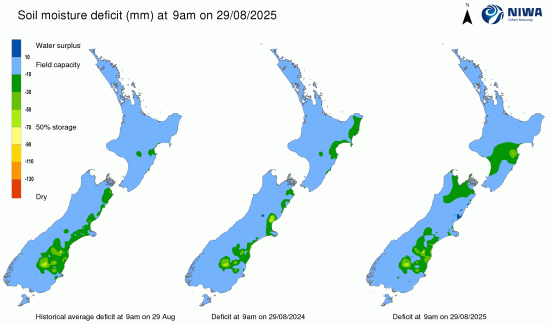Here's our summary of key economic events overnight that affect New Zealand, with news the US dollar is falling, and the benchmark US 10 year treasury yield is down also, near a seven week low. These are the key reactions to the easing of Middle East hostilities.
But first up today, we should note that the weekly Pulse dairy auction for the two main powder products brought lower prices yet again. The SMP price fell -2.6% from last week's full auction to US$2704/tonne, while the WMP price fell -1.9% to US$4006/tonne. They represent yet another retreat which essentially cancels the April to May price gains.
In the US, Fed boss Powell was at Congress today giving his semiannual Monetary Policy Report. He is back again tomorrow. He repeated that they are in no rush to cut rates, certainly not in July, and that their scenario of two more -25 bps reductions in 2025 remains their current outlook. Their focus is on inflation risks which they still have worries about, not economic growth, and that is helped by a stable labour market.
Meanwhile, the weekly Redbook survey of the US retail impulse showed sales volume growth easing lower, the lowest since the April tariff-tax induced price spike in early April. And if you exclude the seasonal dips at the end of 2024/25, this growth is the lowest since March 2024 even with the tariff-tax push effect on retail pricing.
The US Conference Board's survey of consumer sentiment weakened in June. And this time the weakness spread to 'present conditions'. They report consumers were more pessimistic about business conditions and job availability over the next six months, and optimism about future income prospects eroded. It is a trend they have been noting since the start of 2025.
Also fading was the Richmond Fed's latest factory survey for June. Although new order intakes declined more slowly, it still declined and the order backlogs in the region are now falling faster. Unless they get an improvement in new orders, production cutbacks are looking. And the service sector survey in the same mid-Atlantic states region is no better. In this district too, reshoring is not in evidence.
We should also note that credit stress for US commercial real estate is staying unusually high. This extended trouble will force an increasing number of lenders there to book losses, and because the worst losses are coming from the largest buildings, it could be destabilising for some mid-sized banks. (See this, more than half way down the page.)
There was a large well supported US Treasury bond auction earlier today for their 2 year Note. This delivered a median yield of 3.73%, down from the 3.90% at the prior equivalent event a month ago.
In Canada, their May inflation rate was reported overnight, unchanged at 1.7%, which was the expected result.
Taiwanese retail sales were weaker in May, down -1.6% from the same month a year ago and extending a weaker trend. They were expected to rise marginally. However Taiwanese industrial production was outstandingly strong, up more than +20% from the same month a year ago and extending the April surge.
In South Korea, consumer sentiment has improved sharply since the election of a reform-minded new president. Apart from a brief post-pandemic spike, they haven't been this optimistic there since 2017.
And in case we don't miss it, the German economy is rising again, gaining in confidence and extending the gains that started in mid 2024. The turnaround hasn't been dramatic, but it has built more than you might have thought.
The UST 10yr yield is now at 4.30%, and down -3 bps from this time yesterday. The key 2-10 yield curve is holding at +48 bps. Their 1-5 curve is now inverted by -16 bps. And their 3 mth-10yr curve has essentially held +15 bps. The Australian 10 year bond yield starts today at 4.16% and down -1 bp from yesterday. The China 10 year bond rate is little-changed at 1.65%. The NZ Government 10 year bond rate starts today at 4.45%, down -4 bps.
Wall Street is rising with the S&P500 up +1.2%. However European equity markets were up a bit more in Tuesday trade, but the exception was London which ended unchanged. Tokyo ended yesterday up +1.1%. However Hong Kong was up more, up +2.1% and Shanghai was up +1.2%. Singapore rose +0.6%. The ASX200 ended its Tuesday trade up a full +1.0% too but the NZX50 ended down -0.5%, the only loser in the markets we follow.
The price of gold will start today at US$3,320/oz, and down -US$61 from yesterday.
American oil prices are down another -US$4.50 from yesterday at just over US$64.50/bbl while the international Brent price is now just under US$67.50/bbl as Middle East security concerns seem to fade.
The Kiwi dollar is now just on 60.2 USc, back up +½c from yesterday. Against the Aussie we are +10 bps firmer at 92.6 AUc. Against the euro we are up +20 bps at 51.8 euro cents. That all means our TWI-5 starts today at under 67.9 and +20 bps firmer than yesterday.
The bitcoin price starts today at US$106,141 and up +3.7% from this time yesterday. Volatility over the past 24 hours has been modest at just on +1.9%.
Daily exchange rates
Select chart tabs
The easiest place to stay up with event risk is by following our Economic Calendar here ».
3 Comments
Quick we need to plant more farmland in trees to combat low cloud cover. I'm sure our omnipotent climate changing politicians can come up with a special tax to help us.
Contraction of the World's Storm-Cloud Zones the Primary Contributor to the 21st Century Increase in the Earth's Sunlight Absorption
"The present study shows that, due to the contraction of the world's storm cloud regimes, the general circulation shift component constitutes the dominant term of the recent increase in absorbed solar radiation and provides a crucial missing piece in the puzzle of the 21st century radiative warming and the large heat anomaly of 2023 (Schmidt, 2024). "
https://agupubs.onlinelibrary.wiley.com/doi/10.1029/2025GL114882
profile,
"The present study shows that, due to the contraction of the world's storm cloud regimes, the general circulation shift component constitutes the dominant term of the recent increase in absorbed solar radiation and provides a crucial missing piece in the puzzle of the 21st century radiative warming and the large heat anomaly of 2023 (Schmidt, 2024). "
Interesting material, but why is this happening? Is it related to increased CO2 levels? Irrespective of the cause, what are the policy implications for governments and businesses?
This isn't going away
https://www.rnz.co.nz/news/national/565049/thousands-of-over-65s-earn-m…



We welcome your comments below. If you are not already registered, please register to comment.
Remember we welcome robust, respectful and insightful debate. We don't welcome abusive or defamatory comments and will de-register those repeatedly making such comments. Our current comment policy is here.